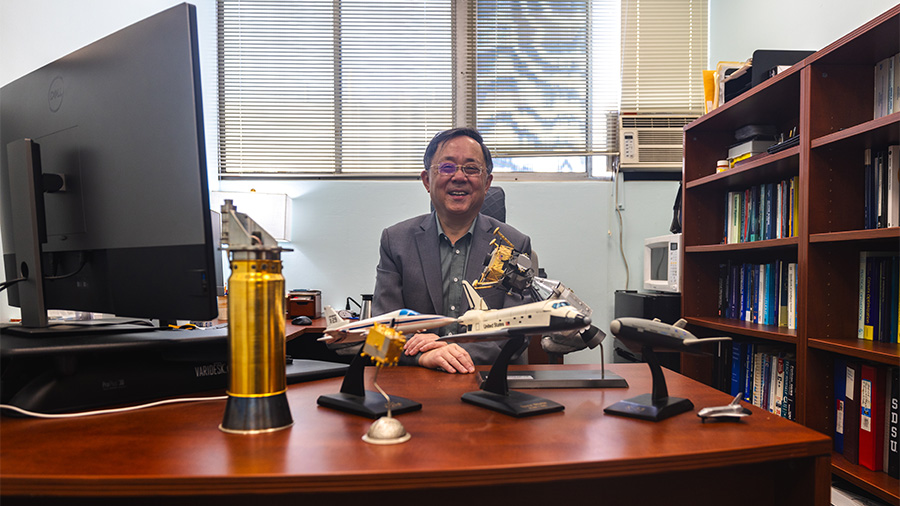SDSU professor’s mission to land humans on Mars is his holy grail of space exploration
Ping Lu to give Albert W. Johnson Distinguished Lecture on March 12

How can we land multiple astronaut-carrying rockets, 50 times heavier than the largest previous Martian robotic rovers, using the least amount of propellant, within meters of each other, close enough to a target destination on Mars, to minimize the distance over which astronauts have to transport scientific equipment?
How can Mars-bound spacecraft accomplish such a precise task when all of their communications can take more than up to 21 minutes to reach the Earth?
To answer these questions about both solved and unsolved challenges to landing humans on Mars, Ping Lu, professor of aerospace engineering at San Diego State University, will deliver the 34th Annual Albert W. Johnson Distinguished Lecture on March 12 (details below).
Lu was nominated for the lecture — SDSU’s highest honor for outstanding research accomplishment and scholarship — by colleagues in his field and then selected after review by a university committee, including prior recipients.
“Professor Lu is truly exceptional in his field and an outstanding example of the translational, applied work on which SDSU prides itself,” said Hala Madanat, vice president for research and innovation.
“Professor Lu is among the most highly cited authors worldwide in aerospace engineering, with truly remarkable and unparalleled contributions to the field of space navigation,” said Eugene Olevsky, dean of SDSU’s College of Engineering. “His receipt of the prestigious Albert W. Johnson Award is a well-deserved recognition of his distinguished work.”
Upon being notified of his selection for the Albert W. Johnson Award, Lu said, “I’m one of the luckiest people living on earth.”
He says the same about the possibility of living to see his life’s work implemented on rockets that will land on Mars.
From farming to fortuitous NASA collaborations
After graduating from high school, Ping Lu worked as a farmer in the countryside as part of a reeducation program at the tail-end of China’s Cultural Revolution.
“At that time, I had no idea what the future would hold. For all I knew, I could be a farmer for life,” Lu said.
Fueled by reading a popular aviation magazine, he did not give up on his dream of studying aerospace engineering. Once college entrance exams were reinstated more than two years later, Lu enrolled at a university in Beijing, then came to the U.S. for graduate school and to start his career as a professor.
Early in his career, Lu had an opportunity to work on NASA’s X-33 program, helping to figure out how a reusable launch vehicle could repeatedly enter orbit and land without a multistage rocket. Although the vehicle was never fully realized, the experience opened more doors for him to bridge between academia and industry.
“If I have any level of success,” Lu said, “it’s because early on, I learned quite a bit from my NASA colleagues about what the real-life challenges are, what an algorithm or technology needs to do for it to be useful.”
Lu’s algorithms are widely regarded as the industry standard for calculating safe trajectories to land rockets efficiently and accurately in seconds. Without his technology, these same calculations would take an army of engineers working for months to find one possible trajectory. For his innovative approach, he earned an award from NASA’s Johnson Space Center during the tenure of SDSU alumna Ellen Ochoa as director.
His algorithms really shine when they must find an optimal landing path with minimal computing power and the limited knowledge we have of extraterrestrial atmospheres. Some of his most cited algorithms are planned to guide rockets to land on the icy worlds of Uranus and Neptune, running on the computing power of an iPhone 4.
Twenty years after his early work at NASA, Lu now serves as the chair of SDSU’s Department of Aerospace Engineering, and he is focused on what he refers to as the “holy grail of space exploration:” landing on Mars.
Building on his previous work, he is tweaking his complex equations to try to safely guide rockets to the surface of Mars using the least amount of propellant possible. So far, he has found a way to save three to five metric tons of fuel per landing— equivalent to the weight of multiple Perseverance rovers —- allowing spacecraft to carry more life support supplies, scientific instruments and fuel for the return journey.
“And that’s possible not because we’re using a different system, but just because we’re using a different brain,” Lu says.
The Albert W. Johnson Distinguished Lecture and awards ceremony are scheduled for 3-6 p.m., March 12, at the Tula Community Center, and are free and open to the public. To register to attend, go online to complete an RSVP form.



